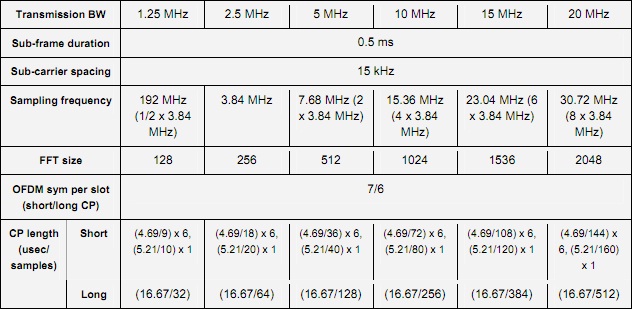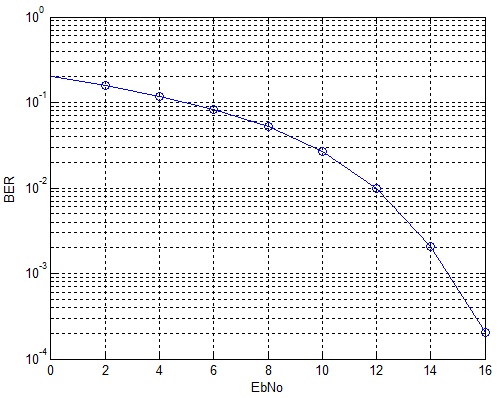64-QAM is an important component of the LTE Air Interface that promises higher data rates and spectral efficiencies. Combined with OFDM and MIMO it successfully combats the detrimental effects of the wireless channels and provides data rates in excess of 100Mbps (peak data rate). Here, we discuss a simple example of 64-QAM modulation with OFDM in an AWGN channel. We assume a bandwidth of 1.25MHz which corresponds to an FFT size of 128.
Given below is the code for this scheme.
%%%%%%%%%%%%%%%%%%%%%%%%%%%%%%%%%%%%%%%%%%%%%%%%%%%%%%%%%%
% FUNCTION TO CALCULATE BER OF 64-QAM OFDM IN AWGN
% n_bits: Input, number of bits
% n_fft: Input, FFT size
% EbNodB: Input, energy per bit to noise PSD
% ber: Output, bit error rate
% Copyright RAYmaps (www.raymaps.com)
%%%%%%%%%%%%%%%%%%%%%%%%%%%%%%%%%%%%%%%%%%%%%%%%%%%%%%%%%%
function[ber]= M_QAM(n_bits,n_fft,EbNodB);
Eb=7;
M=64;
k=log2(M);
EbNo=10^(EbNodB/10);
x=transpose(round(rand(1,n_bits)));
h1=modem.qammod(M);
h1.inputtype='bit';
h1.symbolorder='gray';
y=modulate(h1,x);
n_sym=length(y)/n_fft;
s_ofdm=zeros(1,n_fft);
r_ofdm=zeros(1,n_fft);
for n=1:n_sym;
s_ofdm=sqrt(n_fft)*ifft(y((n-1)*n_fft+1:n*n_fft),n_fft);
wn=randn(1,n_fft)+j*randn(1,n_fft);
r_ofdm=s_ofdm+sqrt(Eb/(2*EbNo))*wn.';
s_est((n-1)*n_fft+1:n*n_fft)=fft(r_ofdm,n_fft)/sqrt(n_fft);
end
h2=modem.qamdemod(M);
h2.outputtype='bit';
h2.symbolorder='gray';
h2.decisiontype='hard decision';
z=demodulate(h2,s_est.');
ber=(n_bits-sum(x==z))/n_bits;
return
%%%%%%%%%%%%%%%%%%%%%%%%%%%%%%%%%%%%%%%%%%%%%%%%%%%%%%%%%%
As discussed previously, with proper normalization of IFFT and FFT operations the performance of OFDM in AWGN is the same as the performance of the underlying modulation scheme. We have not even introduced the cyclic prefix in our simulation because without a fading channel there is no ISI and cyclic prefix (CP) is of no use. We will introduce the CP when we turn our attention to fading channels.
It must be noted that although IFFT and FFT are linear inverses of each other proper normalization is required to maintain the signal levels at the transmitter and receiver.
Author: Yasir Ahmed (aka John)
More than 20 years of experience in various organizations in Pakistan, the USA, and Europe. Worked as a Research Assistant within the Mobile and Portable Radio Group (MPRG) of Virginia Tech and was one of the first researchers to propose Space Time Block Codes for eight transmit antennas. The collaboration with MPRG continued even after graduating with an MSEE degree and has resulted in 12 research publications and a book on Wireless Communications. Worked for Qualcomm USA as an Engineer with the key role of performance and conformance testing of UMTS modems. Qualcomm is the inventor of CDMA technology and owns patents critical to the 4G and 5G standards.


Thanks John!
Where did you get these information like theorem of ber of M-QAM OFDM in AWGN?
From paper or book?
Hi Jhon
How did get the theorem of BER OF M-QAM OFDM IN AWGN ?
In an AWGN channel the BER of M-QAM OFDM is the same as simple M-QAM (ignoring Cyclic Prefix since its not needed in an AWGN channel).
Hi John,
I got it, thanks.
Pedro
Hi,
Thank you for the codes. BTW, could you explain why Eb = 7?
Best regards,
Pedro
Pedro: It is the energy per bit which can also be calculated as
Eb=mean((abs(y)).^2)/k
where y is the symbol stream and k=log2(M) is the number of bits per symbol.
John